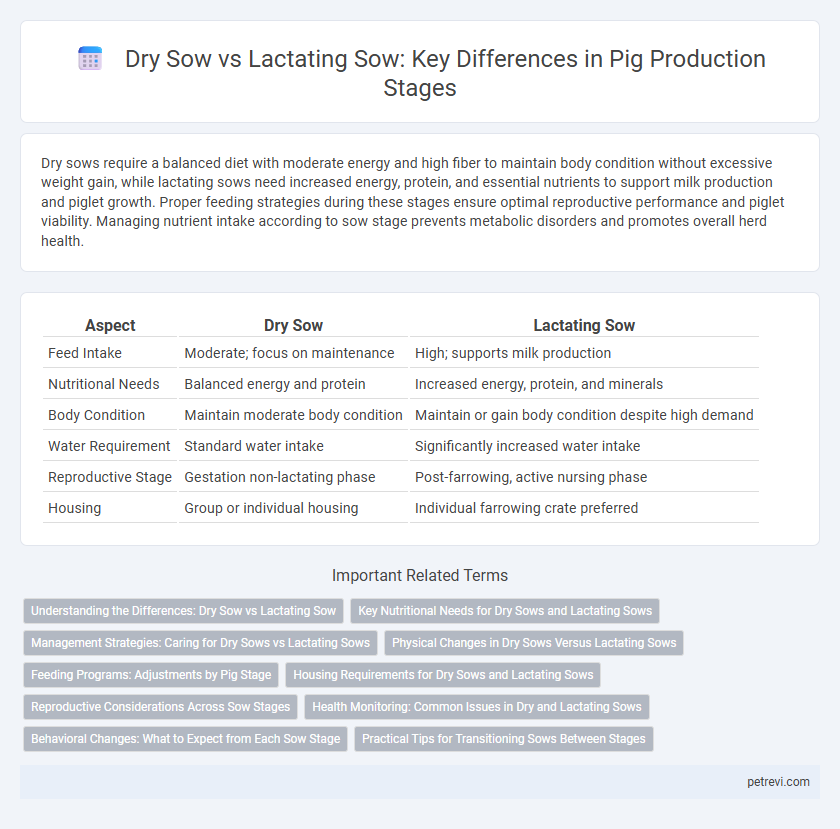Dry sows require a balanced diet with moderate energy and high fiber to maintain body condition without excessive weight gain, while lactating sows need increased energy, protein, and essential nutrients to support milk production and piglet growth. Proper feeding strategies during these stages ensure optimal reproductive performance and piglet viability. Managing nutrient intake according to sow stage prevents metabolic disorders and promotes overall herd health.
Table of Comparison
| Aspect | Dry Sow | Lactating Sow |
|---|---|---|
| Feed Intake | Moderate; focus on maintenance | High; supports milk production |
| Nutritional Needs | Balanced energy and protein | Increased energy, protein, and minerals |
| Body Condition | Maintain moderate body condition | Maintain or gain body condition despite high demand |
| Water Requirement | Standard water intake | Significantly increased water intake |
| Reproductive Stage | Gestation non-lactating phase | Post-farrowing, active nursing phase |
| Housing | Group or individual housing | Individual farrowing crate preferred |
Understanding the Differences: Dry Sow vs Lactating Sow
Dry sows are adult female pigs maintained during the non-lactating phase, primarily focused on body condition recovery and preparation for the next breeding cycle. Lactating sows, on the other hand, are nursing piglets and require higher energy and nutrient intake to support milk production and maintain health. Understanding the distinct nutritional and management needs of dry versus lactating sows is critical for optimizing reproductive performance and piglet growth.
Key Nutritional Needs for Dry Sows and Lactating Sows
Dry sows require diets rich in fiber and controlled energy to maintain body condition without excessive fat deposition, with moderate protein levels ensuring maintenance and reproductive health. Lactating sows need highly digestible energy and increased protein, calcium, and phosphorus to support milk production and meet the nutritional demands of piglets. Both stages demand balanced vitamins and minerals, but lactating sows require elevated levels to prevent deficiency-related reproductive complications and optimize piglet growth.
Management Strategies: Caring for Dry Sows vs Lactating Sows
Management strategies for dry sows prioritize body condition monitoring, ensuring adequate feed to maintain optimal weight without overconditioning, and providing comfortable, clean resting areas to reduce stress and promote reproductive success. For lactating sows, focus shifts to maximizing nutrient-dense diets to support milk production, careful monitoring of hydration levels, and maintaining hygiene in farrowing environments to minimize disease risk and enhance piglet survival. Tailored environmental controls, including temperature regulation and bedding quality, are critical in both stages to support health and productivity.
Physical Changes in Dry Sows Versus Lactating Sows
Dry sows exhibit increased fat deposition and reduced mammary gland size, reflecting a state of energy storage and maintenance. In contrast, lactating sows experience significant mammary gland hypertrophy and mobilize body fat reserves to support milk production. These physiological adaptations are critical for optimizing reproductive performance and piglet growth during the respective stages.
Feeding Programs: Adjustments by Pig Stage
Dry sow feeding programs emphasize controlled energy intake with high-fiber diets to maintain body condition and prevent excessive fat deposition, ensuring optimal reproductive performance. In contrast, lactating sows require nutrient-dense, energy-rich rations with increased protein and electrolyte levels to support milk production and piglet growth. Strategic adjustments in feed composition and volume align with metabolic demands at each stage for maximum sow health and productivity.
Housing Requirements for Dry Sows and Lactating Sows
Dry sow housing requires well-ventilated, spacious pens that allow movement and prevent aggression, typically with solid floors and bedding to ensure comfort during the non-lactation period. Lactating sow housing demands individual farrowing crates designed to provide warmth, easy access to piglets, and controlled temperature, often incorporating heated floors or mats for neonatal piglet comfort. Both housing types must emphasize hygiene, biosecurity, and ease of manure removal to maintain sow health and optimize productivity at each reproductive stage.
Reproductive Considerations Across Sow Stages
Dry sows require a nutrient regimen that supports body condition maintenance and follicular development to ensure optimal ovulation rates during the estrous cycle. Lactating sows demand higher energy and protein intake to sustain milk production and promote uterine involution, facilitating prompt return to estrus. Balancing reproductive hormone levels and managing body reserves across these stages is crucial to maximize fertility and litter performance in commercial swine production.
Health Monitoring: Common Issues in Dry and Lactating Sows
Health monitoring in dry sows focuses on managing body condition, preventing lameness, and ensuring optimal feed intake to prepare for the next gestation. Lactating sows require vigilant observation for mastitis, metritis, and agalactia (MMA syndrome), as well as maintaining hydration and electrolyte balance to support milk production. Both stages benefit from regular veterinary checks to detect reproductive tract infections and metabolic disorders early.
Behavioral Changes: What to Expect from Each Sow Stage
Dry sows typically exhibit increased resting behavior and reduced activity as they focus on conserving energy for the upcoming lactation period. Lactating sows display heightened nursing and protective instincts, along with more frequent postural changes to accommodate piglets' suckling needs. Behavioral shifts such as increased vocalizations and interactions with piglets are common during lactation, reflecting maternal care and bonding.
Practical Tips for Transitioning Sows Between Stages
Transitioning sows from the dry sow stage to lactation requires gradual dietary adjustments, increasing energy and protein levels to support milk production and piglet growth. Maintaining consistent environmental conditions and minimizing stress during this period promotes feed intake and overall sow health. Monitoring body condition score ensures sows do not lose excessive weight, optimizing reproductive performance in subsequent cycles.
Dry sow vs Lactating sow for Pig stage Infographic

 petrevi.com
petrevi.com